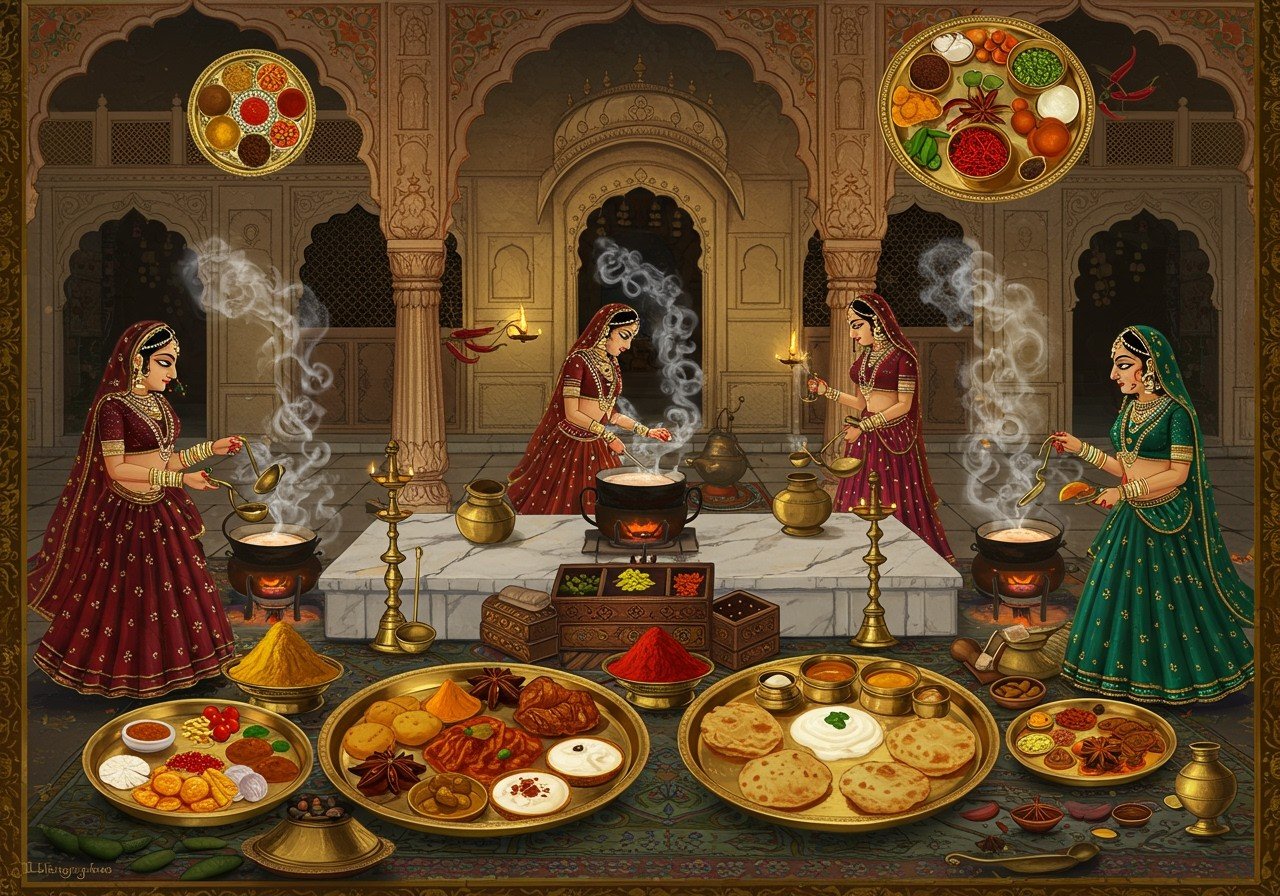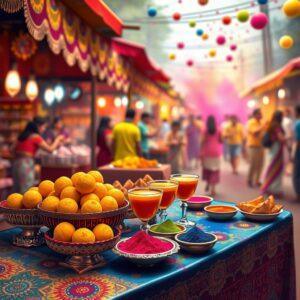
Embark on a historical journey through the culinary traditions of Mewar, a region renowned for its rich culture and heritage. Understand Mewar’s significance within the broader context of Rajasthani cuisine, and explore how its unique geography, history, and cultural practices have influenced its food. This article delves into traditional Mewari dishes, culinary customs, and the intertwining of food and spirituality in Mewar.
Historical Context of Mewar’s Cuisine
Mewar, a princely state in Rajasthan, boasts a rich history deeply intertwined with its local cuisine. The region’s arid climate and limited water resources have shaped its culinary practices, fostering resourcefulness and ingenuity. The Rajput warrior class, with their demanding lifestyle, favored robust, hearty dishes. Trade routes and interactions with neighboring regions introduced diverse ingredients and techniques, enriching Mewar’s culinary landscape. Furthermore, key historical events, such as wars and alliances, played a role in shaping the cuisine, introducing new ingredients and cooking methods. Royal patronage played a crucial role in preserving culinary traditions, with royal kitchens serving as centers of innovation and refinement. These practices, dating back to the 16th-18th centuries, are documented in historical texts and manuscripts, offering glimpses into Mewar’s culinary past.
Traditional Mewari Dishes
Mewari cuisine is celebrated for its iconic dishes, each boasting unique flavors that reflect the region’s history and environment:
- Dal Bati Churma: A simple yet flavorful dish made of lentils (dal), baked wheat balls (bati), and sweet crumbled wheat balls (churma). This hearty meal is a staple in Mewari cuisine, representing resourcefulness and adaptability to the arid climate.
- Laal Maas: A fiery mutton curry known for its rich, spicy flavor. This dish is a testament to the Rajput warrior heritage, reflecting their preference for bold and flavorful food. The vibrant red color comes from the generous use of Mathania red chilies.
- Gatte ki Sabzi: This dish features gram flour dumplings (gatte) simmered in a tangy, yogurt-based gravy. It showcases the culinary ingenuity of Mewar, utilizing readily available ingredients to create a flavorful and satisfying meal.
- Ker Sangri: A unique dish prepared with desert beans (sangri) and dried berries (ker). This dish embodies the spirit of resourcefulness, utilizing ingredients found in the desert landscape. It’s a testament to Mewar’s ability to create delicious meals from locally sourced ingredients.
- Ghevar and Mawa Kachori: These are popular sweets showcasing Mewar’s expertise in confectionery. Ghevar, a disc-shaped sweet made with flour, ghee, and sugar syrup, is especially popular during festivals. Mawa kachori, a flaky pastry filled with sweetened milk solids, is a beloved treat.
- Mohan Maas: A royal delicacy of mutton cooked in milk and mild spices, showcasing the rich culinary heritage of the Mewar royal kitchens. This dish is a testament to the refined culinary traditions and the use of unique cooking methods.
Local spices and herbs, such as red chilies, turmeric, coriander, and cumin, lend Mewari dishes their distinctive taste.
Culinary Customs in Mewar
Unique culinary customs define Mewar’s food culture:
- Cooking in earthenware: This traditional practice enhances the flavor of dishes and is believed to retain nutrients. It’s a testament to Mewar’s respect for traditional cooking methods and the unique flavors they impart.
- Community meals: During festivals and celebrations, community meals foster a sense of togetherness. These shared meals strengthen social bonds and celebrate Mewar’s rich cultural heritage.
- The concept of ‘Thali’: The ‘Thali,’ a platter containing a variety of dishes, is central to Mewari dining traditions. It offers a balanced and flavorful meal, showcasing the diversity of Mewari cuisine.
- Food preservation: Methods like drying and pickling are employed to preserve seasonal ingredients, showcasing the practicality and resourcefulness of Mewar’s culinary practices. These methods allow for the enjoyment of local produce throughout the year.
- Women’s role: Women play a significant role in cooking and passing down recipes through generations. This matrilineal culinary heritage ensures the preservation of Mewar’s unique culinary traditions.
- Seasonal ingredients: The use of seasonal ingredients reflects a deep connection to agricultural cycles and the local environment. This practice ensures the freshest and most flavorful ingredients are used in Mewari dishes.
- Rituals: Rituals like offering food to deities before meals demonstrate the integration of spirituality into everyday life. This practice highlights the reverence for food and its connection to the divine.
Food and Spirituality in Mewar
Food and spirituality are deeply intertwined in Mewar:
- Prasad: The practice of offering food to deities and consuming it as ‘Prasad’ is a central aspect of Mewari spirituality. This ritual signifies gratitude and reverence for the divine.
- Fasting: Fasting practices influence cuisine, with specific dishes prepared for fasting days. These dishes often adhere to specific dietary restrictions while remaining flavorful and nutritious.
- Vegetarianism: Jain and Vaishnav traditions have significantly influenced the prevalence of vegetarian cuisine in Mewar. This emphasis on vegetarianism reflects the region’s spiritual values and respect for all life forms.
- Festivals: Special dishes prepared during religious festivals often carry symbolic meanings. These culinary traditions add a deeper layer of significance to celebrations and reinforce cultural identity.
- Satvik food: ‘Satvik’ food, considered pure and spiritually uplifting, is highly valued. This dietary approach emphasizes fresh, natural ingredients and simple cooking methods.
- Rituals: Food plays a vital role in rituals like weddings and other life-cycle ceremonies. These culinary traditions mark important occasions and reinforce social bonds.
Enhance Your Mewar Culinary Experience with Traditional Dining Essentials
Experience the authentic flavors of Mewar cuisine with Poojn’s traditional dining essentials. Our Customised Fabric Coloured Hand-Printed Clay Dinner Set perfectly complements the rich culinary heritage of Mewar. This traditional dining set includes a 12-inch thali, 5 serving bowls, and 1 glass, all crafted from natural clay – just like how the royalty of Mewar enjoyed their meals.
The clay dinner set, available at ₹699 (reduced from ₹1,499), helps maintain the authentic taste of traditional Rajasthani dishes. Clay vessels are known to enhance the natural flavors of spices and ingredients commonly used in Mewar cuisine. The hand-printed fabric design on the set reflects the artistic heritage of the region.
For a complete traditional dining experience, explore our Holy Utensils collection featuring 40+ authentic items. Our clay items section offers more traditional cookware and serving options that align with Mewar’s culinary customs. Visit poojn.in to discover our full range of traditional dining essentials that help preserve and celebrate Mewar’s rich culinary heritage.
Conclusion
Mewar’s cuisine transcends mere sustenance; it embodies the region’s rich history, culture, and spirituality. The traditional dishes, unique culinary customs, and the profound connection between food and spirituality illuminate Mewar’s vibrant heritage. By appreciating and preserving these culinary traditions, we honor Mewar’s legacy and ensure that future generations can savor and understand the flavors and customs that define this remarkable region. Whether you are a newcomer to Mewar’s cuisine or rediscovering your roots, the culinary journey is both enriching and delightful.
Sun Temple Modhera: A Cultural and Culinary Exploration
Hinduism’s Impact: A Culinary Exploration of Local Cuisines
Gujarati Culture: Festivals, Cuisine, and Customs Explored


